Investigation on Long-Term Stability of Vermiculite Seals for Reversible Solid Oxide Cell
Abstract
:1. Introduction
2. Results and Discussions
2.1. The Investigation of Leakage Rates
2.2. Evaluation of Long-Term Sealing Performance
2.3. Estimation of Vermiculite Seals for Stack Application
3. Materials and Methods
4. Conclusions
- (1)
- The sealing performance of vermiculite gradually deteriorated with increasing thickness and input gas pressure. The thinner seals had good sealing performance. The coordination between assembly and compression could achieve electrical contact between cells and interconnects as well as achieve sealing performance. Moreover, the higher the compressive load, the smaller the leakage rates under the same input gas pressure. The compressive load was carried out at seals, the possible holes were squeezed, and finally the leakage rates were lower. The temperature had less influence on sealing performance. Finally, thinner seals with a suitable compressive load exhibited a good sealing performance.
- (2)
- To further examine the long-term stability of vermiculite, the seals underwent long-term operation at 750 °C, and twenty thermal cycles from 750 °C to 200 °C were conducted. With a fixed input gas pressure of 1 psi, 2 psi, and 3 psi, the leakage rates remained at around 0.009 sccm/cm, 0.017 sccm/cm and 0.028 sccm/cm during twenty thermal cycles. Additionally, the leakage rates remained at around 0.011 sccm/cm during 240 h. Simultaneously, elemental diffusions between seals and components were limited, implying good compatibility.
- (3)
- The maximum current density was 1.01 A/cm2 at a voltage of 1.3 V after ten thermal cycles. Furthermore, the open circuit voltage (OCV) remained at around 1.04 V during 17 thermal cycles, which is close to Nernst potentials. Moreover, the performance of the stack stayed roughly stable during thermal cycles. The stack performance confirmed that the vermiculite seals can meet the structural support and sealing requirements. Therefore, the vermiculite shows good promise for application in stacks undergoing many thermal cycles and wide input gas pressure ranges.
Author Contributions
Funding
Institutional Review Board Statement
Informed Consent Statement
Data Availability Statement
Acknowledgments
Conflicts of Interest
Sample Availability
References
- Yang, C.; Guo, R.; Jing, X.; Li, P.; Yuan, J.; Wu, Y. Degradation Mechanism and Modeling Study on Reversible Solid Oxide Cell in Dual-Mode—A Review. Int. J. Hydrogen Energy 2022, 47, 37895–37928. [Google Scholar] [CrossRef]
- Königshofer, B.; Boškoski, P.; Nusev, G.; Koroschetz, M.; Hochfellner, M.; Schwaiger, M.; Juričić, Đ.; Hochenauer, C.; Subotić, V. Performance Assessment and Evaluation of SOC Stacks Designed for Application in a Reversible Operated 150 kW rSOC Power Plant. Appl. Energy 2021, 283, 116372. [Google Scholar] [CrossRef]
- Preininger, M.; Stoeckl, B.; Subotić, V.; Mittmann, F.; Hochenauer, C. Performance of a Ten-Layer Reversible Solid Oxide Cell Stack (rSOC) under Transient Operation for Autonomous Application. Appl. Energy 2019, 254, 113695. [Google Scholar] [CrossRef]
- Yao, Y.; Ma, Y.; Wang, C.; Ye, H.; Liu, Y.; Liu, J.; Zhao, X.; Tao, T.; Yao, Y.; Lu, S.; et al. A Cofuel Channel Microtubular Solid Oxide Fuel/electrolysis Cell. Appl. Energy 2022, 327, 120010. [Google Scholar] [CrossRef]
- Venkataraman, V.; Pérez-Fortes, M.; Wang, L.; Hajimolana, Y.S.; Boigues-Muñoz, C.; Agostini, A.; McPhail, S.J.; Maréchal, F.; Van Herle, J.; Aravind, P.V. Reversible Solid Oxide Systems for Energy and Chemical Applications—Review & Perspectives. J. Energy Storage 2019, 24, 100782. [Google Scholar] [CrossRef]
- Vitale, F.; Rispoli, N.; Sorrentino, M.; Rosen, M.A.; Pianese, C. On the Use of Dynamic Programming for Optimal Energy Management of Grid-Connected Reversible Solid Oxide Cell-Based Renewable Microgrids. Energy 2021, 225, 120304. [Google Scholar] [CrossRef]
- Li, Q.; Kuang, K.; Sun, Y.; Zheng, Y.; Liu, Q.; Chan, S.H.; Zhang, H.; Wang, W.; Li, T.; Wang, J. Deficiency of Hydrogen Production in Commercialized Planar Ni-YSZ/YSZ/LSM-YSZ Steam Electrolysis Cells. Int. J. Hydrogen Energy 2022, 47, 23514–23519. [Google Scholar] [CrossRef]
- Sezer, H.; Mason, J.H.; Celik, I.B.; Yang, T. Three-Dimensional Modeling of Performance Degradation of Planar SOFC with Phosphine Exposure. Int. J. Hydrogen Energy 2021, 46, 6803–6816. [Google Scholar] [CrossRef]
- Fergus, J.W. Sealants for Solid Oxide Fuel Cells. J. Power Sour. 2005, 147, 46–57. [Google Scholar] [CrossRef]
- Mahapatra, M.K.; Lu, K. Glass-Based Seals for Solid Oxide Fuel and Electrolyzer Cells—A Review. Mater. Sci. Eng. R Rep. 2010, 67, 65–85. [Google Scholar] [CrossRef]
- Kiebach, R.; Engelbrecht, K.; Grahl-Madsen, L.; Sieborg, B.; Chen, M.; Hjelm, J.; Norrman, K.; Chatzichristodoulou, C.; Hendriksen, P.V. An Ag Based Brazing System with a Tunable Thermal Expansion for the Use as Sealant for Solid Oxide Cells. J. Power Sour. 2016, 315, 339–350. [Google Scholar] [CrossRef]
- Zhang, Y.C.; Jiang, W.; Tu, S.T.; Wang, C.L.; Chen, C. Effect of Operating Temperature on Creep and Damage in the Bonded Compliant Seal of Planar Solid Oxide Fuel Cell. Int. J. Hydrogen Energy 2018, 43, 4492–4504. [Google Scholar] [CrossRef]
- Sasaki, K.; Muranaka, M.; Terai, T. Compatibility Analysis of Ag and Electrolyte Materials for LT-SOFCs and LT-SOECs. Solid State Ion. 2010, 181, 1303–1307. [Google Scholar] [CrossRef]
- Li, S.; Cai, Y.; Zhu, Q.; Liu, Z.; Zhang, Y. Interface Degradation of Glass-to-Metal Seals during Thermo-Oxidative Aging. Corros. Sci. 2022, 199, 110189. [Google Scholar] [CrossRef]
- Sabato, A.G.; Rost, A.; Schilm, J.; Kusnezoff, M.; Salvo, M.; Chrysanthou, A.; Smeacetto, F. Effect of Electric Load and Dual Atmosphere on the Properties of an Alkali Containing Diopside-Based Glass Sealant for Solid Oxide Cells. J. Power Sour. 2019, 415, 15–24. [Google Scholar] [CrossRef]
- Elsayed, H.; Javed, H.; Sabato, A.G.; Smeacetto, F.; Bernardo, E. Novel Glass-Ceramic SOFC Sealants from Glass Powders and a Reactive Silicone Binder. J. Eur. Ceram. Soc. 2018, 38, 4245–4251. [Google Scholar] [CrossRef]
- Peigat, L.; Reytier, M.; Ledrappier, F.; Besson, J. A Leakage Model to Design Seals for Solid Oxide Fuel and Electrolyser Cell Stacks. Int. J. Hydrogen Energy 2014, 39, 7109–7119. [Google Scholar] [CrossRef]
- Wakita, Y.; Tachikawa, Y.; Nakajima, H.; Hamada, S.; Ito, K. Visualization and Mechanical Strength of Glass Seal in Planar Type Solid Oxide Fuel Cells. Int. J. Hydrogen Energy 2020, 45, 21754–21766. [Google Scholar] [CrossRef]
- Li, R.; Peng, L.; Wang, X.; Yang, J.; Yan, D.; Pu, J.; Chi, B.; Li, J. Investigating the Performance of Glass/Al2O3 Composite Seals in Planar Solid Oxide Fuel Cells. Compos. Part B Eng. 2020, 192, 107894. [Google Scholar] [CrossRef]
- Mahapatra, M.K.; Lu, K. Seal Glass for Solid Oxide Fuel Cells. J. Power Sour. 2010, 195, 7129–7139. [Google Scholar] [CrossRef] [Green Version]
- Tong, J.; Du, X.; Han, M. The Development of Sealant for Planar SOFC. ECS Trans. 2013, 57, 2395–2401. [Google Scholar] [CrossRef]
- Tulyaganov, D.U.; Reddy, A.A.; Kharton, V.V.; Ferreira, J.M.F. Aluminosilicate-Based Sealants for SOFCs and Other Electrochemical Applications—A Brief Review. J. Power Sour. 2013, 242, 486–502. [Google Scholar] [CrossRef]
- Li, R.; Tao, M.; Wang, P.; Yang, J.; Ma, B.; Chi, B.; Pu, J. Effect of Interconnect Pre-Oxidation on High-Temperature Wettability and Mechanical Properties of Glass Seals in SOFC. J. Am. Ceram. Soc. 2021, 104, 6172–6182. [Google Scholar] [CrossRef]
- Li, S.; Hu, K.; Hui, W.; Cai, Y.; Zhu, Q.; Zhang, Y. Morphological Evolution of Oxide Layer and Its Effect on Glass-to-Metal Seal. J. Non. Cryst. Solids 2020, 549, 120355. [Google Scholar] [CrossRef]
- Li, S.; Hu, K.; Hui, W.; Cai, Y.; Zhang, Y. Shear Strength and Interfacial Characterization of Borosilicate Glass-to-Metal Seals. J. Alloys Compd. 2020, 827, 154275. [Google Scholar] [CrossRef]
- Li, R.; Liang, X.; Wang, X.; Zeng, W.; Yang, J.; Yan, D.; Pu, J.; Chi, B.; Li, J. Improvement of Sealing Performance for Al2O3 Fiber-Reinforced Compressive Seals for Intermediate Temperature Solid Oxide Fuel Cell. Ceram. Int. 2019, 45, 21953–21959. [Google Scholar] [CrossRef]
- Li, S.; Zhu, Q.; Hu, K.; Cai, Y.; Liu, Z.; Chen, F.; Zhang, Y. Determination of Compressive Stress in Glass-to-Metal Seals Using Photoluminescence Spectroscopy Technique. Ceram. Int. 2022, 48, 13379–13385. [Google Scholar] [CrossRef]
- Li, R.; Wang, X.; Peng, L.; Jiang, B.; Yang, J.; Yan, D.; Pu, J.; Chi, B.; Li, J. Thermal Cycling Stability of Novel Hexagonal Boron Nitride (H-BN)/glass Compressive Seals for Planar Intermediate Temperature Solid Oxide Fuel Cells. J. Alloy Compd. 2020, 843, 155620. [Google Scholar] [CrossRef]
- Chou, Y.S.; Stevenson, J.W. Long-Term Ageing and Materials Degradation of Hybrid Mica Compressive Seals for Solid Oxide Fuel Cells. J. Power Sour. 2009, 191, 384–389. [Google Scholar] [CrossRef]
- Chou, Y.S.; Stevenson, J.W.; Singh, P. Thermal Cycle Stability of a Novel Glass-Mica Composite Seal for Solid Oxide Fuel Cells: Effect of Glass Volume Fraction and Stresses. J. Power Sour. 2005, 152, 168–174. [Google Scholar] [CrossRef]
- Chou, Y.S.; Stevenson, J.W. Novel Infiltrated Phlogopite Mica Compressive Seals for Solid Oxide Fuel Cells. J. Power Sour. 2004, 135, 72–78. [Google Scholar] [CrossRef]
- Chou, Y.-S.; Stevenson, J.W.; Hardy, J.; Singh, P. Material Degradation during Isothermal Ageing and Thermal Cycling of Hybrid Mica Seals under Solid Oxide Fuel Cell Exposure Conditions. J. Power Sour. 2006, 157, 260–270. [Google Scholar] [CrossRef]
- Chou, Y.-S.; Stevenson, J.W. Long-Term Thermal Cycling of Phlogopite Mica-Based Compressive Seals for Solid Oxide Fuel Cells. J. Power Sour. 2005, 140, 340–345. [Google Scholar] [CrossRef]
- Alves, L.R.P.S.T.; Alves, M.D.T.C.; Honorio, L.M.C.; Moraes, A.I.; Silva-Filho, E.C.; Peña-Garcia, R.; Furtini, M.B.; da Silva, D.A.; Osajima, J.A. Polyurethane/Vermiculite Foam Composite as Sustainable Material for Vertical Flame Retardant. Polymers 2022, 14, 3777. [Google Scholar] [CrossRef]
- Mahato, N.; Banerjee, A.; Gupta, A.; Omar, S.; Balani, K. Progress in Material Selection for Solid Oxide Fuel Cell Technology: A Review. Prog. Mater. Sci. 2015, 72, 141–337. [Google Scholar] [CrossRef]
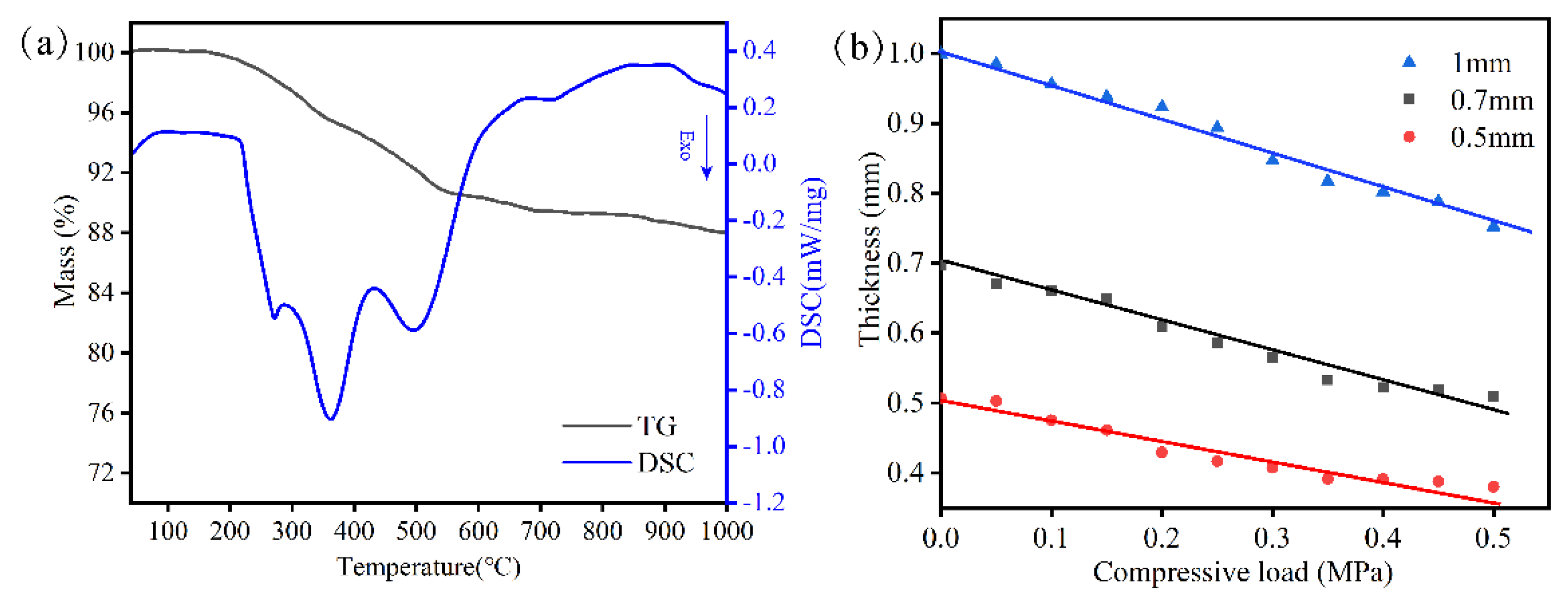
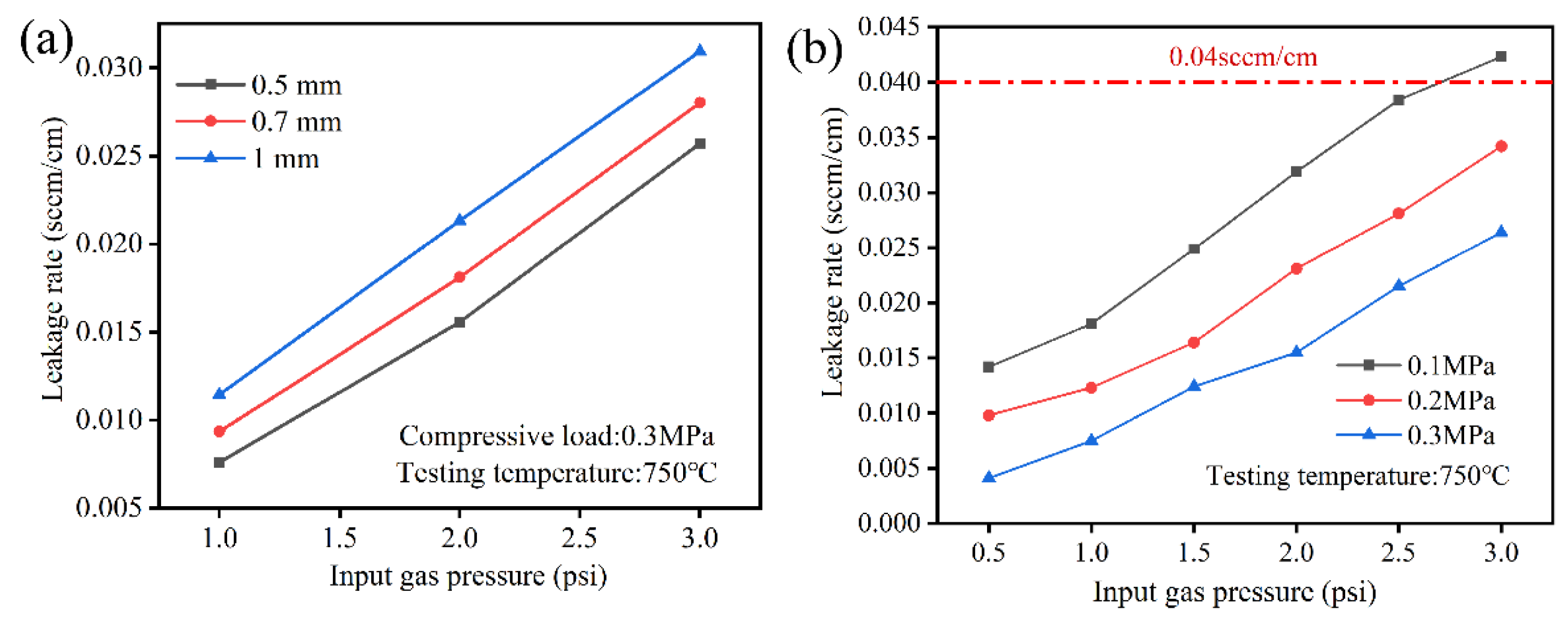


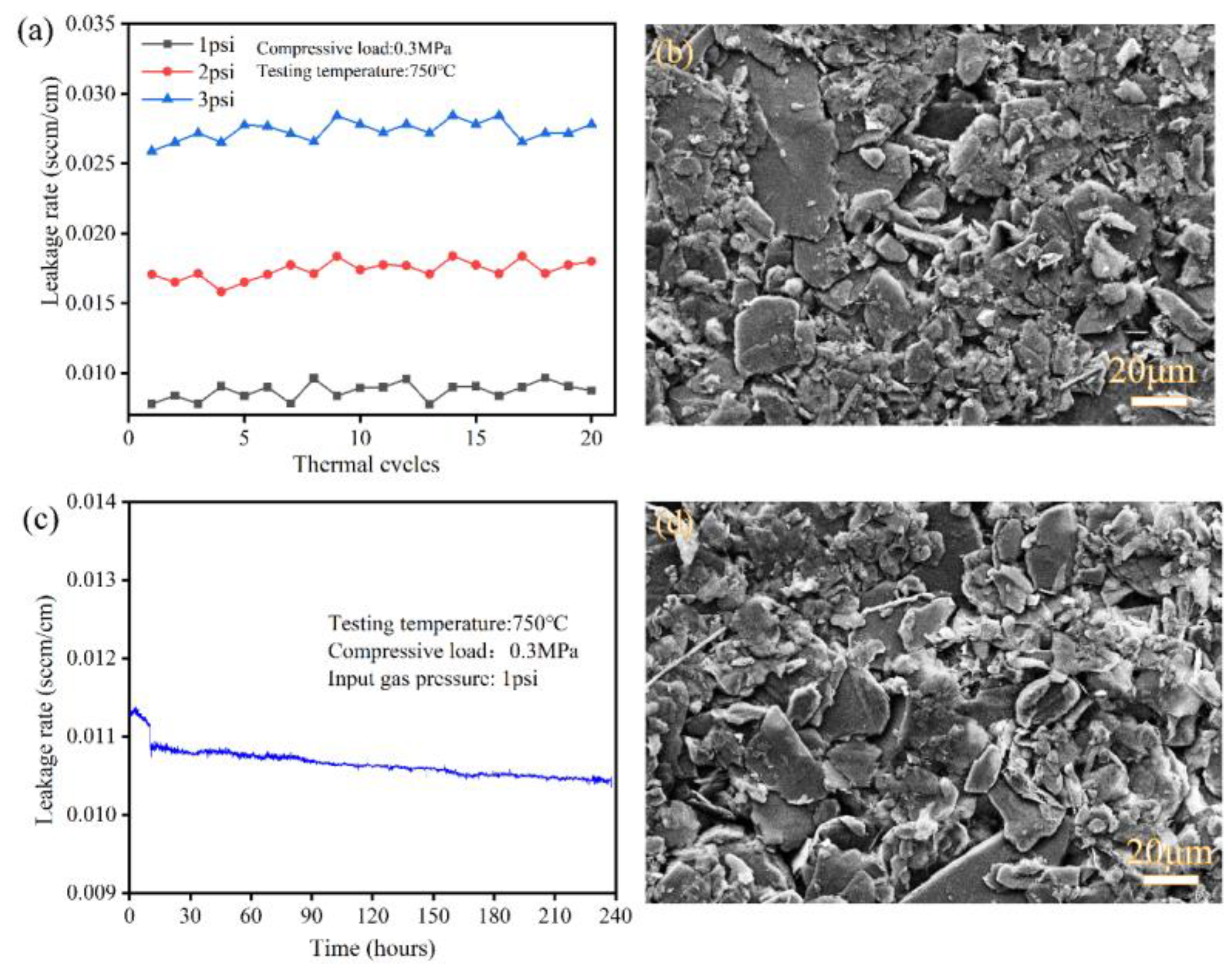
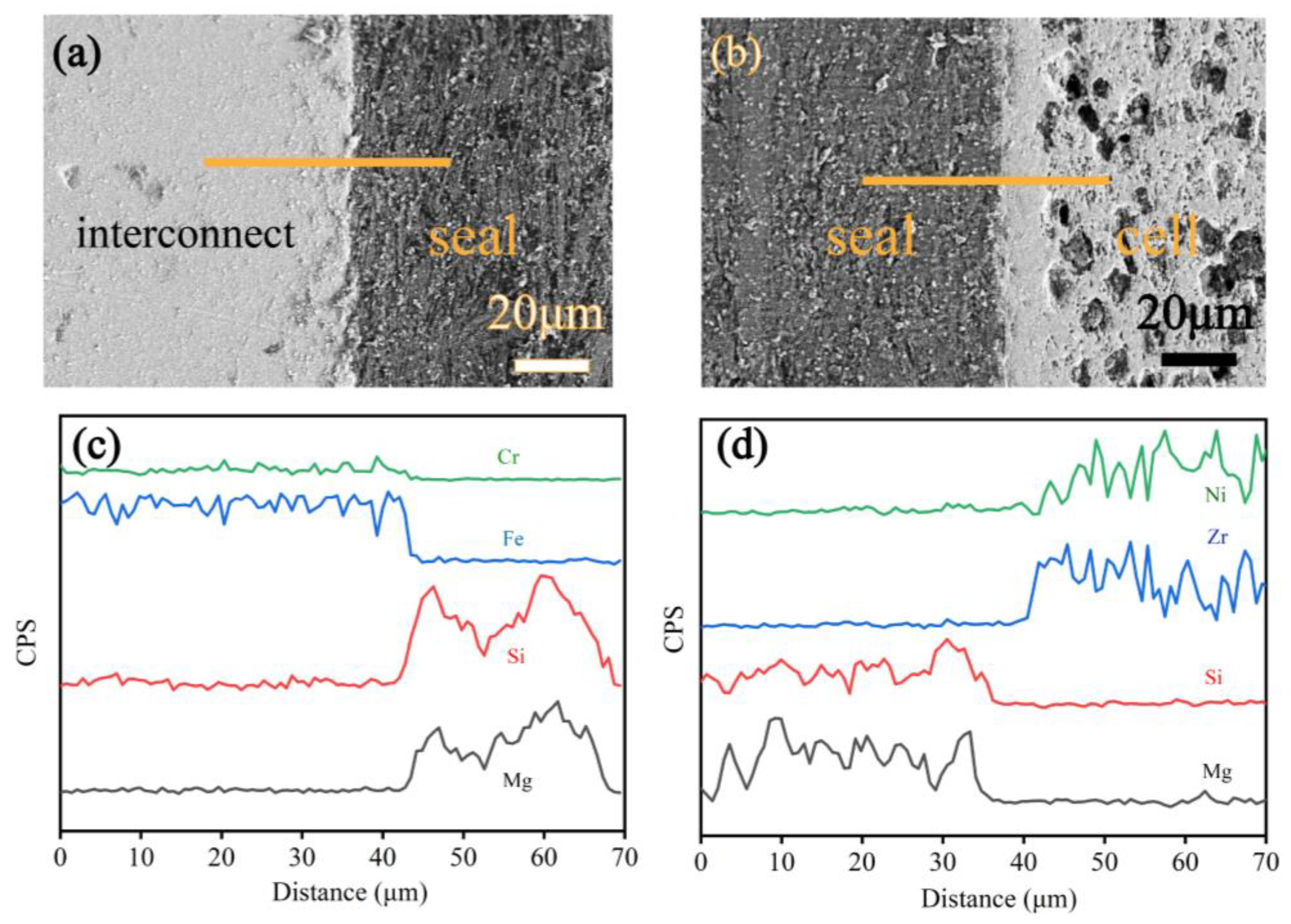
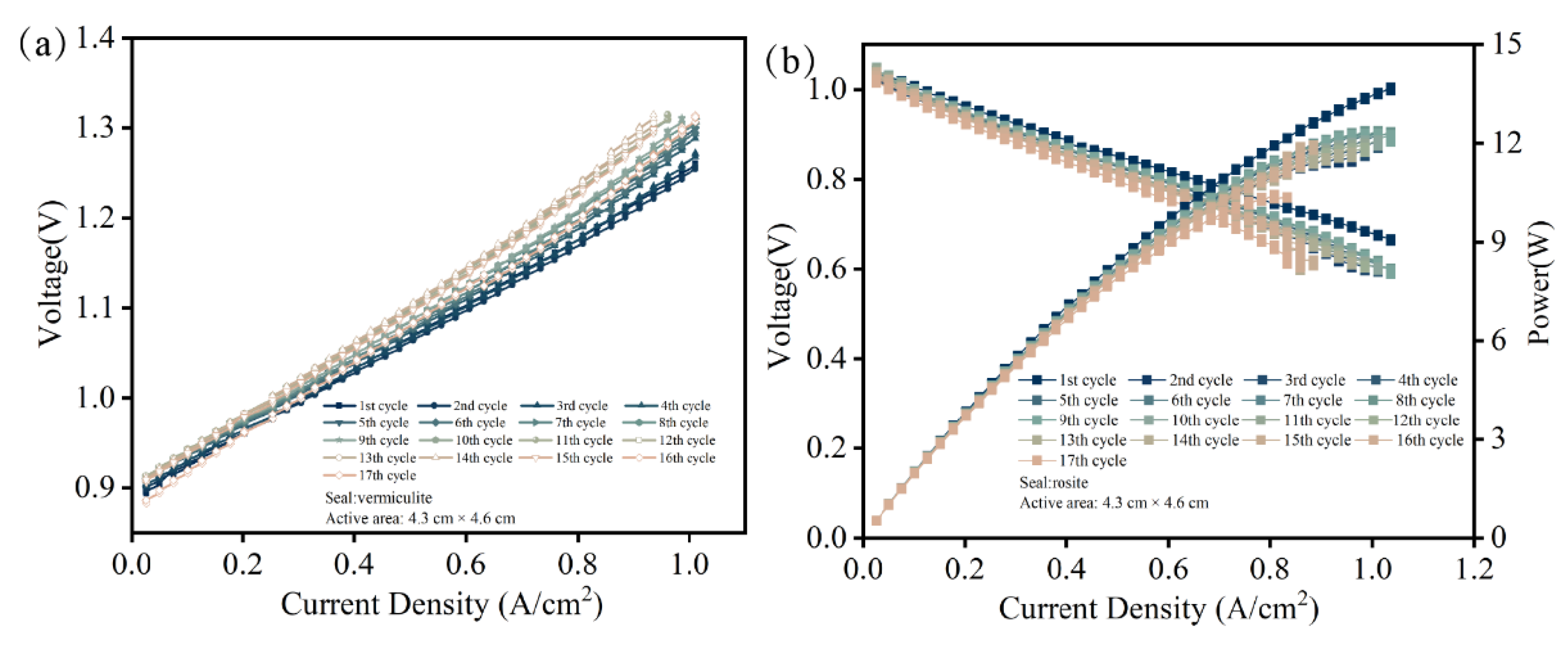
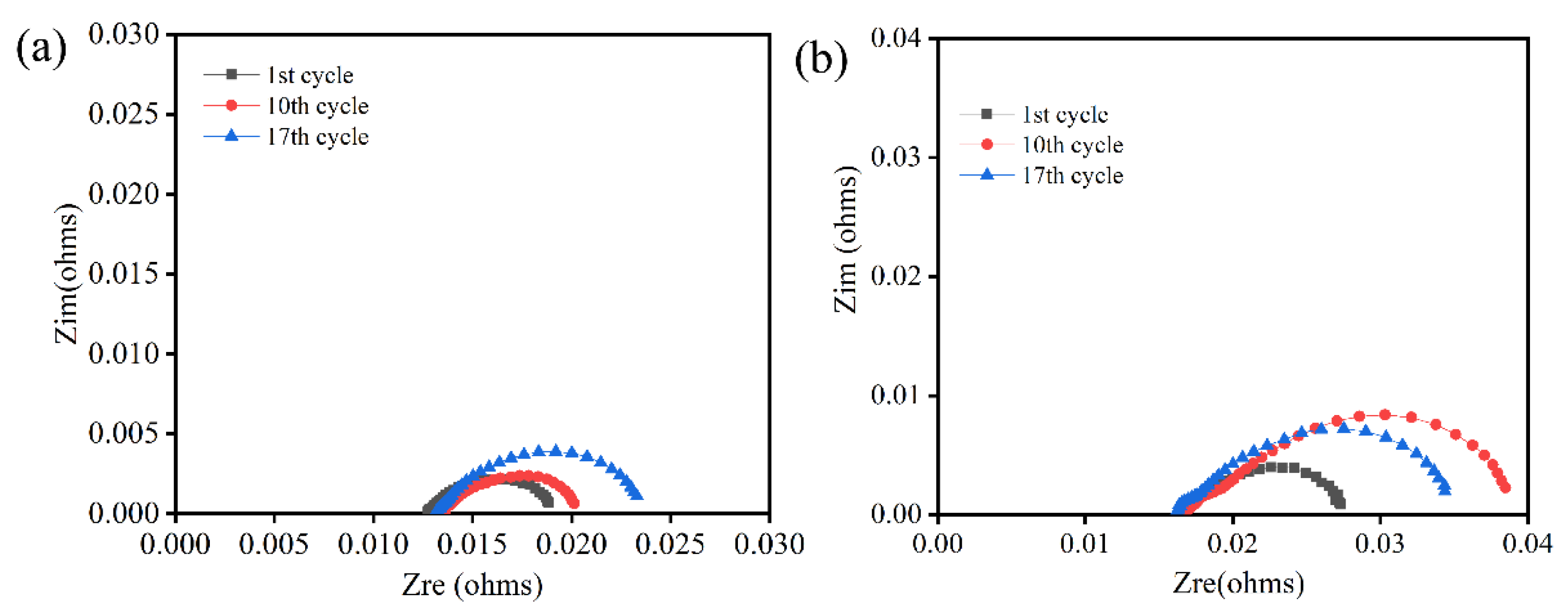
Disclaimer/Publisher’s Note: The statements, opinions and data contained in all publications are solely those of the individual author(s) and contributor(s) and not of MDPI and/or the editor(s). MDPI and/or the editor(s) disclaim responsibility for any injury to people or property resulting from any ideas, methods, instructions or products referred to in the content. |
© 2023 by the authors. Licensee MDPI, Basel, Switzerland. This article is an open access article distributed under the terms and conditions of the Creative Commons Attribution (CC BY) license (https://creativecommons.org/licenses/by/4.0/).
Share and Cite
Li, R.; Lu, Y.; Yu, Y.; Ren, X.; Ding, F.; Guan, C.; Wang, J. Investigation on Long-Term Stability of Vermiculite Seals for Reversible Solid Oxide Cell. Molecules 2023, 28, 1462. https://doi.org/10.3390/molecules28031462
Li R, Lu Y, Yu Y, Ren X, Ding F, Guan C, Wang J. Investigation on Long-Term Stability of Vermiculite Seals for Reversible Solid Oxide Cell. Molecules. 2023; 28(3):1462. https://doi.org/10.3390/molecules28031462
Chicago/Turabian StyleLi, Ruizhu, Yue Lu, Yutian Yu, Xianzhi Ren, Feng Ding, Chengzhi Guan, and Jianqiang Wang. 2023. "Investigation on Long-Term Stability of Vermiculite Seals for Reversible Solid Oxide Cell" Molecules 28, no. 3: 1462. https://doi.org/10.3390/molecules28031462
APA StyleLi, R., Lu, Y., Yu, Y., Ren, X., Ding, F., Guan, C., & Wang, J. (2023). Investigation on Long-Term Stability of Vermiculite Seals for Reversible Solid Oxide Cell. Molecules, 28(3), 1462. https://doi.org/10.3390/molecules28031462




